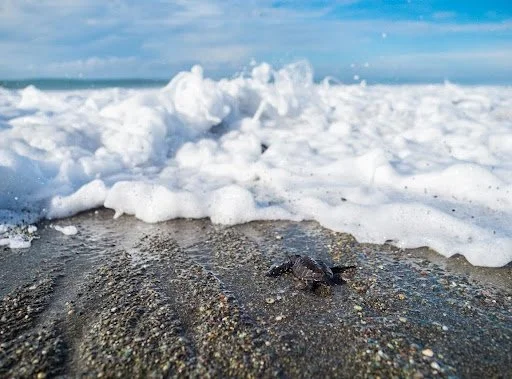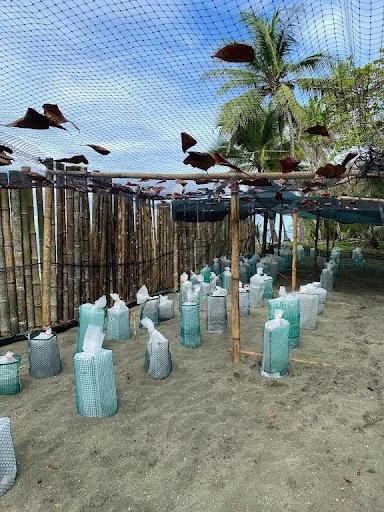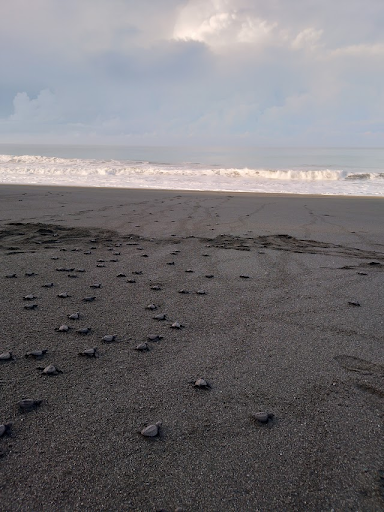Sea Turtle Conservation
By Kylie Baker
Photo Credit: Alex Van Calster
At 6 am, back in Seattle, I would definitely still be sleeping. My earliest school mornings entailed bundling up for my biology labs and trekking across campus in the rain to Hitchcock Hall. I never expected that for the fall quarter of my third year at UW, I would wake up at 4:30 am for a morning sea turtle census. Now, I walk to the outdoor bathroom and showers, my headlamp the only apparent light source, with howler monkeys roaring in the jungle nearby. And by 6 am, I am releasing baby sea turtle hatchlings into the Pacific Ocean's warm waters from the Osa Peninsula coast in Costa Rica.
What began as a simple application to a Sea Turtle Conservation Internship from a SEFS career newsletter led to a quarter of fieldwork study at Osa Conservation. Osa Conservation is a nonprofit organization dedicated to protecting and preserving the biodiversity of the Osa Peninsula, with programs in restoration, wildlife, sustainable farming, and more. So while my peers enjoy the autumn weather and Dawg Saturdays, I am basking in the warmth of the tropics and observing wild and beautiful forms of nature.
Early morning wake-ups prepare us to go out on the morning census, where we monitor Piro Beach, a 2 km long important nesting beach for the threatened olive ridley and green sea turtles. The Tortuga (turtle) Team is a small collection of interns from around the world, united by our love for nature and wildlife. We find and relocate threatened nests to the hatchery, giving them a greater chance of survival. We also record essential data to assess population trends and predation rates, and complete post-hatched nest excavations to determine hatching success. As interesting as data collection is, the most enjoyable and rewarding part is releasing the baby sea turtle hatchlings.
Photo Credit: Kylie Baker
The hatchery is an open mesh structure that encloses part of the beach, with bamboo posts as support beams and a bamboo wall that acts as a wave breaker. This is where we relocate and rebury threatened nests, and around 60 days later, they hatch. We walk along the beach to reach the hatchery and check our baskets for any hatched nests. We use baskets so the hatchlings do not wander loose, and to keep the data for each nest and treatment group organized.
These baskets house masses of tiny wriggling figures climbing over each other to reach their innate destination: the ocean. They’re greenish-brown, sandy, small, and delicate, and their tiny flippers pedal against my fingers as they wriggle for freedom. From the baskets, we move them to buckets and walk outside the hatchery to the beach. On the beach, I feel the damp sand and hear the crash of large waves as the mist from the ocean casts a slight fog over the rainforest. Insects chirp all around us and the occasional bird calls in the distance. We lift them from the buckets, and once placed onto the sand, they immediately crawl towards the water, carving small trails into the otherwise pristine surface. My eyes grow sore from gazing across the bright beach to trace their paths, but I feel comfort in knowing I played a part in protecting such brilliant creatures.
Photo Credit: Kylie Baker
I would never have expected to be such an early riser, let alone enjoy it. Coming to the jungle for three months was one of the boldest decisions I’ve ever made, and I’m happy I stepped outside the environment of Seattle I’m used to. National Geographic describes the Osa Peninsula as “the most biologically intense place on earth”, and I agree. I am humbled and in awe of the wildness here, and I wouldn’t have wanted to spend fall quarter any other way. The University of Washington provided me with the tools and resources to pursue my goals and opportunities. I awake each day grateful for what I’ve learned, the people I’ve met, and the places I’ve seen. Now, I’m motivated to wake up earlier than ever and go save some baby sea turtles.



